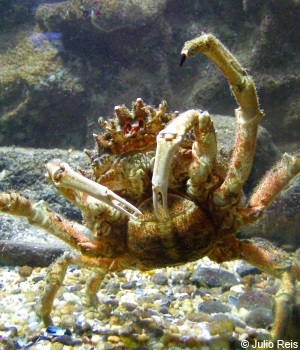
- Scientific name: Maja squinado (but see below)
- Also known as: Common Spider Crab, Spiny Spider Crab
- Size: Up to 20cm across carapace
- Distribution: Found throughout European waters, especially the Mediterranean and parts of the Atlantic Ocean.
The European spider crab is a large species of crab found around the British and Irish coastline. This species of crab is commercially valuable around much of Europe and, unlike other species, takes part in annual migrations.
Description
The European spider crab a circular body which is usually light orange to brown in colour (although this may be red in the breeding season) and covered in bumps and has small spines running along the edge. Its legs are usually a darker orange and are very long and have two joints in them. The long arms have two joints in them and terminate in small claws. As one of the largest crab species in British waters the European spider crab can have a carapace which is up to 20cm across and the claw to claw measurement of the outstretched arms of a fully grown male can be over 50cm.
Distribution, Feeding and Behaviour

As a species which prefers warmer waters, the European spider crab is found throughout the Mediterranean Sea, along the Portuguese coast and the Atlantic coastlines of Spain and France and around northern Africa. The British Isles marks the edge of its northern distribution where it is found around the south and west of England and parts of Wales and Ireland. It is mostly absent from the North Sea and more northerly parts of England and Scotland. European spider crabs can be found across a range of seabeds including stony, heavy rock and weeds.
The European spider crab feeds on plant matter, shellfish and will also eat animals such as starfish, brittle stars, marine worms, although they will also feed on any other sources of food they come across. This species undertakes some form of migration where they move in great numbers (presumably as a defence against predators) into deeper water, often covering tens of miles over several months. This migration is poorly understood but is thought to be linked to reproduction. In summer 2022 thousands of spider crabs swarmed into shallow waters across beaches in Cornwall. It was believed that the crabs had moved into the shallow water as part of their migration to shed their shells, and returned to deeper water once this process was complete.
Species Confusion
It is now accepted that European spider crabs found in the Atlantic Ocean and Mediterranean Sea are genetically different to the extent that there can be regarded as two separate species. Those in the Atlantic have been given the scientific name Maja brachydactyla, while those in the Mediterranean and are now classed as Maja squinado. The differences between these species are minimal and it would take a marine biologist to distinguish between the two species. For this reason they are considered together as a single species on this page. Despite this, it may be important to class the species separately in commercial catches to monitor numbers accurately and keep track of catch levels. The great spider crab (Hyas araneus) is also occasionally found in UK waters, mostly in the North Sea around Scotland and Northern England. It is found across rocky and broken coastline and offshore down to water depths of around 100 metres. Despite being called the great spider crab this species is actually smaller than the European spider crab, growing to a maximum size of around 8 – 9cm across the carapace.
Commercial Value of European Spider Crab

European spider crab is a commercially valuable species due to the edible white meat found in its legs and claws. There is a fishery for this species of crab, mostly concentrated around ports in the south-west of England and parts of Ireland, although the European fishery for this species is much larger. There is little demand for this species of crab from UK consumers meaning that the vast majority of British catches of this species are exported to continental Europe. Restrictions such as a minimum landing size and bans on harvesting egg-bearing females have been brought in to attempt to limit catches and prevent overfishing of this species.